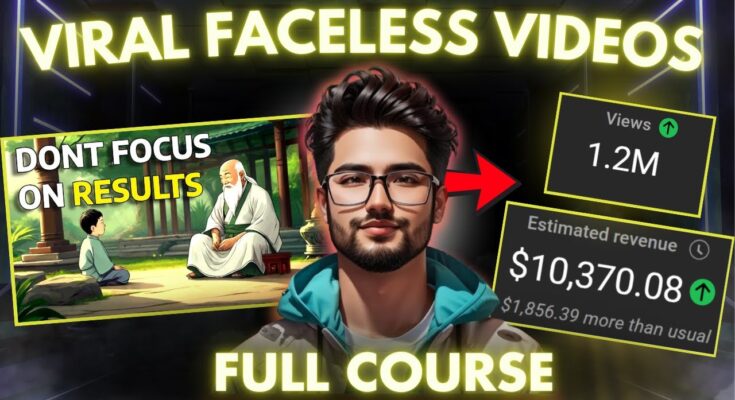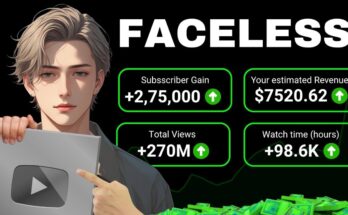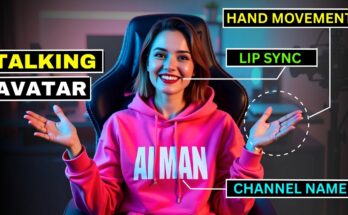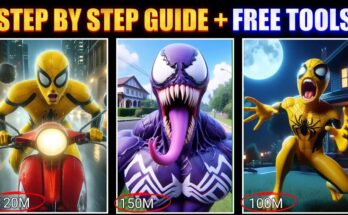1. Introduction: The Power of Faceless YouTube Channels
When I first heard about faceless YouTube channels making thousands of dollars a month, I was skeptical. The idea that you could earn a full-time income without showing your face, recording your voice, or using expensive gear sounded too good to be true. But after months of experimenting, learning, and optimizing, I built a faceless YouTube channel that now generates over $10,000 per month—using only free AI tools. In this article, I’ll walk you through exactly how I did it, and how you can too.
2. What Is a Faceless YouTube Channel?
A faceless YouTube channel is exactly what it sounds like—a channel that doesn’t feature you (or anyone) on camera. Instead of vlogs or talking-head videos, these channels use visuals like stock footage, animations, text overlays, or AI-generated content. Popular niches include motivation, tech, news, true crime, and facts. These channels thrive because the focus is on content and value—not personality. You don’t need to be an influencer to succeed.
3. Choosing a Profitable Niche
Picking the right niche is one of the most important decisions. I analyzed channels in niches like:
-
Luxury & success
-
Tech tutorials
-
History & documentary
-
Finance & investing
-
Motivation & self-improvement
I settled on motivational content, because it consistently performs well, has global appeal, and is perfect for automation. I used tools like Google Trends, VidIQ, and TubeBuddy (free versions) to validate demand and low-competition topics within the niche.
4. Scripting Videos with AI
Creating scripts was my first challenge, but AI made it easy. I used ChatGPT to generate full-length video scripts by feeding it prompts like:
With a bit of editing and personal touches, I had high-quality scripts ready in minutes. For variety, I also asked the AI to write in different tones (inspirational, aggressive, calm), depending on the video’s theme.
5. AI Voiceovers: Free and Realistic
Once the scripts were ready, I needed a narrator—but I didn’t want to pay for voice actors. I turned to free AI voice generators like:
-
ElevenLabs (free tier)
-
TTSMP3
-
Murf.ai (limited free use)
These tools offer surprisingly realistic voices that sound almost human. I experimented with different accents and tones until I found one that matched my brand. I also layered soft background music (from YouTube’s free audio library) to enhance engagement.
6. Creating Videos Without Filming
For visuals, I used free stock video platforms like:
-
Pexels
-
Pixabay
-
Videvo
-
Canva (free account)
I mixed motivational scenes—sunrises, people working out, cityscapes, nature—with animated text overlays using CapCut (desktop version) and DaVinci Resolve (both free). The result? Clean, professional-looking videos that kept viewers watching.
7. Editing and Uploading with Consistency
I stuck to a schedule: three videos per week. Each video was around 5–8 minutes long, which helped boost watch time. I used free YouTube thumbnail makers like Canva and Snappa, ensuring each thumbnail was bold, high-contrast, and had minimal text. Titles were optimized using free SEO tools and ChatGPT prompts like:
Within a month, I had 15 videos published and my first 1,000 subscribers.
8. Getting Monetized: Reaching 1K Subs and 4K Watch Hours
To qualify for YouTube monetization, you need 1,000 subscribers and 4,000 watch hours in the last 12 months. I reached both in just under 60 days. My strategy:
-
Shared videos in motivation-related Reddit and Facebook groups (without spamming)
-
Optimized titles and tags for trending topics
-
Asked viewers to subscribe at the end of each video
Once monetized, YouTube began showing ads on my videos. My CPM (cost per 1,000 views) averaged $7–$15, thanks to being in a high-paying niche.
9. Scaling with Automation and Repurposing
With proof of concept and monetization achieved, I scaled. I used more AI tools like:
-
ChatGPT for batch scripting
-
Pictory.ai and Lumen5 for automated video creation (with limited free versions)
-
Notion to organize scripts, upload schedules, and video ideas
I also repurposed content into Instagram Reels and TikTok clips using vertical templates, pulling quotes from my own videos. This helped drive additional traffic to my channel, growing my audience even faster.
10. Final Thoughts: Yes, It’s Real—and You Can Do It Too
Creating a faceless YouTube channel that earns $10,000/month is absolutely possible—and I’m proof. But it doesn’t happen overnight. It took planning, consistency, and leveraging the right free AI tools to speed up the process. The best part? I didn’t need a camera, microphone, or editing background. Just creativity, persistence, and the willingness to learn.
Whether you’re starting from scratch or already on YouTube, there’s no better time than now to build an automated channel. The tools are free, the audience is global, and the opportunity is real. Start small, stay consistent, and let AI do the heavy lifting.



